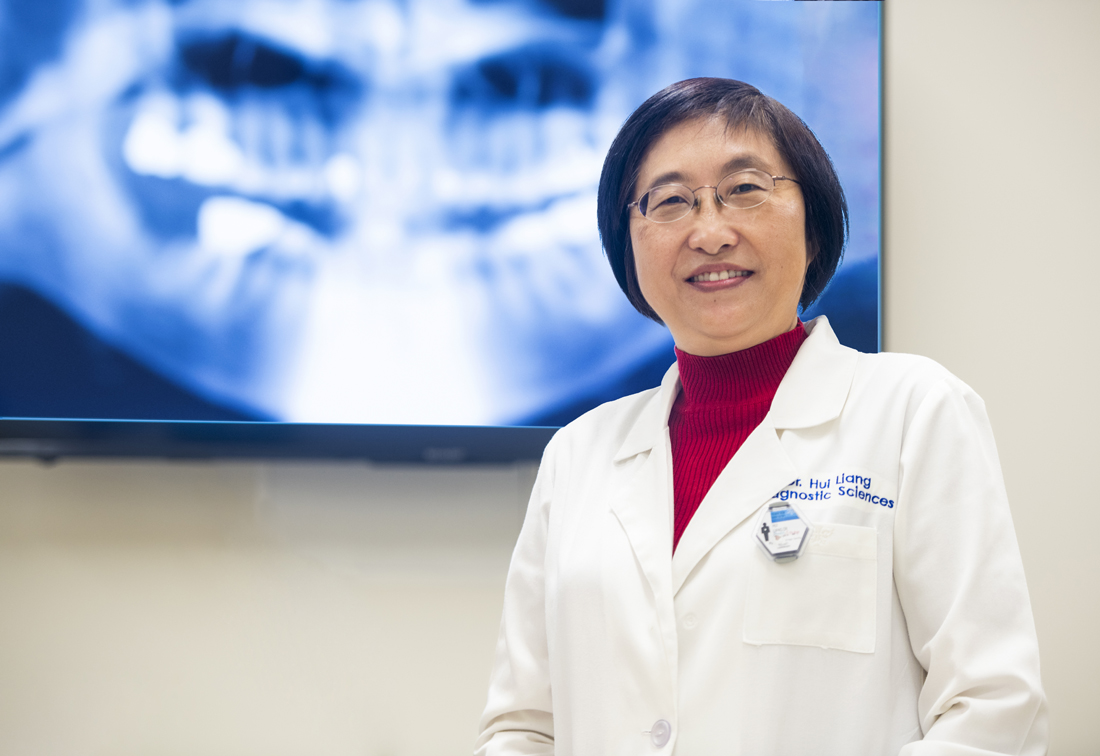Ensuring X-ray safety

Dr. Hui Liang’s work helps protect countless students, faculty, staff and patients, but she emphasizes the team effort that promotes her success as radiation safety officer for Texas A&M College of Dentistry.
“It takes a village,” she says. “I appreciate the faculty and staff who collaborate with me, and I enjoy the environment and people.”
Liang is the acting director of the Department of Diagnostic Sciences’ radiology division. She is also acting director of the college’s graduate program in oral and maxillofacial radiology and one of three board-certified faculty members who staff the college’s Oral and Maxillofacial Imaging Center.
“I’ve been at the college for 23 years. I enjoy working in this department and have developed a good relationship with both faculty and staff. Our students have a good experience in clinical radiology, and our department head, Dr. Yi-Shing Lisa Cheng, is very supportive for our division,” Liang says.
This Q&A offers a glimpse into Liang’s perspective and expertise in clinical radiology.
How does the college ensure effectiveness and safety in dental radiography?
We verify the digital radiographic imaging sensors located collegewide to ensure they do not adversely affect the diagnostic quality of radiographs. Every four years, a certified physicist physically checks each of the 93 X-ray units at the college to determine that they are functioning within state and federal guidelines. They are more stable than one would think; only rarely is one found to malfunction. Nonetheless, significant record keeping is required to meet state regulations.
The calibration is tested on each unit based on the manufacturer’s technical parameters. If the test results show good radiographic density and contrast, this exposure is deemed acceptable for the patient at this site. We post the specific numbers for that unit to ensure students use the correct exposure for their patients. We also check that proper infection control procedures for the unit are being followed. Students are observed to see that they are following proper “radiation hygiene” or safety procedures, and that the lead apron is in good condition or needs replacement.
Selected patient chart audits occur every month to check image quality and procedure compliance. Most of the problems found are that images are not saved to the server to ensure the patients’ records are maintained. Faculty and residents in the radiology division assist with quality control issues, as do radiology and clinical affairs staff members.
An annual check of the non-dental simulation units in the preclinical labs ensures that scatter radiation does not exceed the standard amount. In addition, the operating and safety procedures manual for X-ray units receives a yearly update.
How do your quality assurance efforts impact students? What takeaways can they build on for improvement? What exactly are you checking in their work?
Division faculty present the radiology lectures for D1 and junior dental hygiene students on intraoral and extraoral radiographic techniques. We emphasize attention to quality so that students can recognize any quality issues when taking images in the clinic, and eventually troubleshoot the problems. This does not always happen on the student’s first clinical experience. In the clinic, students are observed for following proper technique and infection control methods. If any improvements are indicated, the staff will do an in-service remediation to help the student become more efficient and accurate when taking X-rays. The staff members have a passion for teaching along with the faculty and residents, and they strive to create a pleasant environment for the students.
Interpretation skills in radiology rely on attention to detail, and this is strongly emphasized to students. They must learn to examine every area in the radiographic image and then combine that information with clinical and historical findings to develop a diagnosis and treatment plan.
What about radiation safety for patients? What processes help keep them safe?
It is important for the students to follow the exposure technique postings specific for each X-ray unit to ensure the radiation exposure for the patient is as low as reasonably achievable. For example, a higher exposure might appear to create a little better image, but it doesn’t necessarily increase the diagnostic accuracy; only the absorbed dose of the patient. At the same time, techniques are consistent. We observe students for violations in radiation protection. This is not only to protect the patient but also protect the student.
What should patients know about the frequency of dental radiographs at their appointments?
Patients at high risk for dental disease may require a posterior bitewing exam at six to 12-month intervals. For patients at low risk of dental disease, X-rays may only be needed using longer intervals. The American Dental Association has established guidelines concerning these recommended intervals and serves as an adjunct to the dentist’s professional judgment of how best to use diagnostic imaging for each patient. Patients should be encouraged to ask questions so they will know the policy at their dental office. As radiologists at a dental school, we try to educate the students about these guidelines and how they can use them in their private practice.